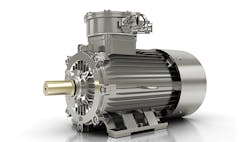Demanding motion applications often transcend industrial contexts
Bruno Chiodi is engineering manager at Moog.
Tell us about your company’s state-of-the-art motor or drive.
Bruno Chiodi, engineering manager, Moog: We have a product portfolio that covers all the different industrial applications. For instance, our compact DM2020 with its multi-axis structure improves the energy efficiency of a system, especially when used in conjunction with the Moog DE2020 energy management module.
Also read: Smarter drives mean more useful motors
What have been the biggest improvements to motor and drives in the past five years?
Bruno Chiodi, engineering manager, Moog: There’s been a push toward a direct integration of motors and drives, which is clearly reshaping the market. These types of decentralized solutions are changing the design of new machines, reducing cabinet sizes and machine footprint. We see and contribute to developments toward seamless incorporation of these decentralized axes into classic multi-axis design.
What’s the most innovative or efficient motor/drive application you’ve ever seen or been involved with?
Bruno Chiodi, engineering manager, Moog: The electrification of construction and agricultural vehicles (CAVs). This is a field where Moog is active with its platform, and there are innovations taking place. The integration of motor and drive systems that went from an industrial context into these demanding, independent applications, with all the challenges that come with it, is stimulating the ideation and development of innovative solutions.
How have motors and drives benefitted from remote monitoring and connectivity?
Bruno Chiodi, engineering manager, Moog: High-speed fieldbuses and machine-to-machine (M2M) connections are changing the game for industrial products. Internet-of-Things (IoT) capability opens new possibilities for remote monitoring and predictive maintenance; and more data about motor and drive working conditions must be measured and processed.
Can you explain how software development has changed motor and drive design and production?
Bruno Chiodi, engineering manager, Moog: From a design point of view, engineers can predict and solve mechanical, electrical and thermal issues using simulation software. Application problems and drive-tuning can also be simulated to reduce commissioning time in the field. On the production side, automatic test and data collection reduce the time to manufacture products and improve quality. These improvements stem from the wide availability of design and production software and the integration of software with the product firmware; that’s an added value of the product.
How do motors and drives figure into digital-twin platform models being used by manufacturers?
Bruno Chiodi, engineering manager, Moog: With the availability of reliable mathematical models of drives and motors, machine builders can access the information necessary to create the machine digital twin. From a component point of view, this means that providing an ever-increasing wealth of data becomes an integral part of developing the product. Without reliable data sets on a component level, accurate modeling is impossible.
When will motors and drives become IT-friendly enough that engineers are no longer required for installation and operation?
Bruno Chiodi, engineering manager, Moog: We are getting close to this situation. In simple applications with advanced graphical user interface (GUI), it’s possible to configure a system in a few steps without a deep knowledge of drives or electric motors. It’s less necessary to possess in-depth engineering know-how; smart systems can handle themselves with less human input and focus on design and model-based preemptive troubleshooting, anticipating issues and implementing solutions within the system before it is even installed.
What future innovations will impact the use of motors and drives in discrete-manufacturing operations?
Bruno Chiodi, engineering manager, Moog: Integrated and decentralized drive products enable engineers to provide a modular design for a customer’s machine, which facilitates implementing discrete-manufacturing systems. The expansion of this decentralized approach to machine design will lead to innovations that impact how teams conceptualize discrete manufacturing.


